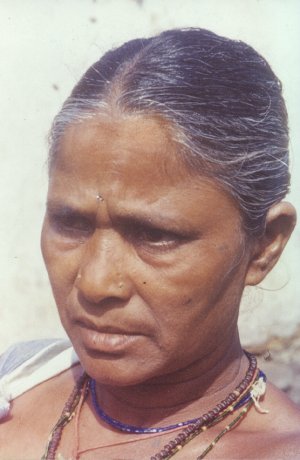The Kadukuruba Community
by Jyotsna Kamat
First Online: April 10, 2004
Page Last Updated: December 07, 2024
The word Kuruba means "shepherd" in Kannada, and Kadu is forest. Kadukuruba-forest shepherd is a misnomer. They do not raise sheep. Instead these tribals collect honey (jenu) and some who are identified as Betta-Kurubas produce household items like baskets and sieves. Ethnically Jenu Kurubas and Betta Kurubas (Betta = hill) are the same. But their professions over centuries, unnoticed has brought in rift, after their contact with so called civilized society.
Honey collection is seasonal and the inter-action of Jenu Kurubas with traders took place occasionally. Betta Kurubas had better contacts because bamboo goods could be woven in and out of season and could be sold throughout the year. They are also elephant trainers.
There are about two thousand households (hadis) or settlements of Kadu Kurubas along Kabini river, Nagarhole river and Nugu river. Each settlement may consist of five to twenty huts. They worked as a community in collection (of honey) production and marketing. Their huts are small with very low doorway. Living space is compact and less. The huts are clean, with fire burning in one corner all the time. Perhaps it was a safety measure to keep wild beasts and reptiles away, while people were busy in the forest.
© K. L. Kamat

The Female of the Tribe
Members of the Bettada-Kuruba tribal community
Like other tribals, there is no gender bias. Marriage takes place early but by mutual consent. There is no concept of owning private property in community living. They lived mainly on forest products. Their delicacy, an old Jenu Kuruba told me was to eat fire-roasted yam (sweet potato or genasu) with honey. Wherever they live, their dream is to eat the delicacies, drink home brewed ragi liquor and sing to the accompaniment of 'bunde' (burude or small drum).
Their peaceful life came to an end about twenty-five years ago. The Government declared this area as most backward and started improving living standard which in practice meant cutting down trees and making way to agriculture! Dams came up over the said rivers, and irrigable capacity increased. Slowly irrigation spread led to submersion and total denudation of dense forest land.
Cash-crops came up. Tobacco companies set up leaf curing units. These required lot of fuel. Forest trees disappeared in no time. Children of forests were driven out due to new policy of 'Project Tiger' and 'Preserving Forest Wealth' which meant, these tribals were forbidden to enter forest for livelihood. They were forced to work as agricultural laborers on the very land were forest stood once.
© K. L. Kamat

Widow of a Mahut (Elephant Trainer)
A housewife of the Jenu-Kuruba (honey-bee farmers) community, Heggededevana Kote
These days (year 2004) they suffer from malnutrition, poverty, unemployment and repression. No doubt forest land was distributed among certain families. But it took no time for contractors to induce the gullible tribals to sell the trees on land for petty amount. Now, the evacuated tribals cross rivers and work as agricultural laborers in neighboring states for as poor wages as 20/- rupees per day! They have to struggle for existence. They are neither in the forest nor in the so called civilized or urban world to reap the benefits, the Governments (both central and state) is so gracious to grant the scheduled tribals.
This Trishanku or existence between Sylla and Charybdis is awaiting all the tribals in India. Only the region varies.
![]()
See Also:
- Children of the Forest God -- Learn about the little known, but very rich traditions and cultures of the tribals of India
- Jai Karnataka -- Potpourri of topics on Karnataka's history, people, folklore and arts. Includes sub-sections on Mysore, Karavali, and North Karnataka.
